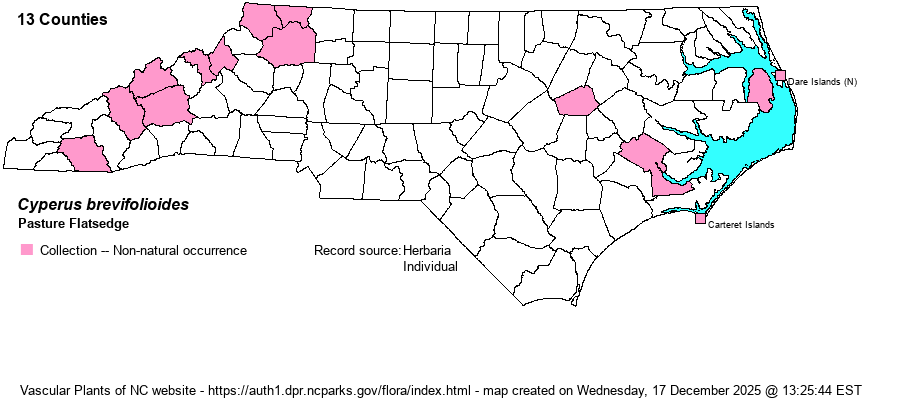| Section 5 » Family Cyperaceae |
Show/Hide Synonym
| taxonName | relationship | relatedTaxonName | relatedTaxonRefText | relComments |
|---|
| Cyperus brevifolioides | = | Kyllinga gracillima | Flora of North America (1993b, 1997, 2000, 2002a, 2002b, 2003a, 2004b, 2005, 2006a, 2006b, 2006c, 2007a, 2009, 2010) | | | Cyperus brevifolioides | = | Kyllinga gracillima | Kartesz (1999) | | | Cyperus brevifolioides | = | Kyllinga gracillima | | | | Cyperus brevifolioides | = | Kyllinga gracillima | Flora of Virginia | | | Cyperus brevifolioides | > | Cyperus brevifolioides | Gleason and Cronquist (1991) | | | Cyperus brevifolioides | > | Cyperus brevifolioides | Godfrey and Wooten (1979, 1981) | | | Cyperus brevifolioides | > | Cyperus brevifolioides | | | | Cyperus brevifolioides | > | Cyperus brevifolioides | Radford, Ahles, and Bell (1968) | | | Cyperus brevifolioides | > | Cyperus brevifolioides | Wofford (1989) | | | Cyperus brevifolioides | > | Cyperus brevifolioides | Goetghebeur & Van den Borre (1989)=V. | | | Cyperus brevifolioides | < | Cyperus brevifolius | Fernald (1950) | | | Cyperus brevifolioides | > | Kyllinga brevifolioides | Goetghebeur & Van den Borre (1989)=V. | | | Source: Weakley's Flora |
|
| Author | Thieret & Delahoussaye | |
| Distribution | Mostly Mountains; disjunct to the Coastal Plain. Specimens at NCU were annotated again in November 2021.
Native to tropical regions. Exotic occurrence from CT and NY south to GA, MS, and AR. | |
| Abundance | Uncommon in Mountains; rare in the Coastal Plain. | |
| Habitat | River sandbars and shores, meadows, pastures, margins of brackish marshes. | |
| Phenology | Flowering and fruiting July-October. | |
| Identification | Pasture Flatsedge grows in small colonies from slender horizontal rhizomes. Stems stand erect, up to a foot tall, topped by a soiltary, pale green, hemispherical or spherical head. In the field plants look pale gray-green or glaucescent. It is a rather handsome plant. Frequently mislabeled or misidentified as C. brevifolius. Most reliable ID character is achene length: usually >1.6 mm vs. <1.4 mm in C. brevifolius. | |
| Taxonomic Comments | A synonym is Kyllinga gracillima.
The genus Cyperus is mostly tropical and warm-temperate in distribution; thus, in NC it is much commoner in the Coastal Plain than in the Mountains and Piedmont. Most species have 1-few flowering stems (culms) from grasslike basal leaves, plus a few stem leaves. At the summit is an inflorescence of very open and branched, or tightly packed, spikes, varying among species from brown to golden brown to straw-color to reddish. The arrangement of the spikelets is important, whether like a hand (digitate) or in paired or alternate rows (pinnate); as is the shape of the achene (seed), whether bi-convex in cross-section or triangular. As a group, Cyperus tends to be weedy and readily enters disturbed ground; this is true for many natives as well as all the aliens. In recent years, following DNA research, the genus has incorporated several genera that in RAB (1968) or other manuals were separate: Hemicarpha, Lipocarpha, and Kyllinga. | |
| Other Common Name(s) | | |
| State Rank | SE | |
| Global Rank | GNR | |
| State Status | | |
| US Status | | |
| USACE-agcp | | |
| USACE-emp | | |

